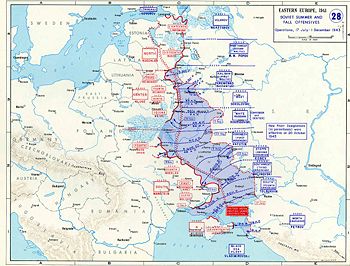- Orsha offensives (1943)
-
Orsha offensives Part of The Eastern Front of World War II Date October 12, 1943 – November 19, 1943 Location Orsha region, Belarus, Soviet Union Result Tactical German victory
Operational Soviet victory
Strategic Soviet victoryBelligerents  Nazi Germany
Nazi Germany Soviet Union
Soviet UnionCommanders and leaders  Gotthard Heinrici
Gotthard Heinrici Sokolovski
SokolovskiStrength 4th Army
193,510 men
Heavy fortificationsWestern Front
310,900 men
steady reinforcementsCasualties and losses 35,056 men 530,537 men[dubious ] Naval warfare
Baltic Sea - Black Sea - Arctic - (Arctic Convoys - Rösselsprung - Wunderland)
1941
Barbarossa - (Białystok and Minsk - Smolensk - Uman - Leningrad - 1st Kiev - Sevastopol - Rostov - Moscow) - Finland - Chechnya
1942
Battles of Rzhev - (Toropets and Kholm - Demyansk - Velikiye Luki - Mars) - 2nd Kharkov - Case Blue - Stalingrad - (Uranus - Winter Storm)
1943
3rd Kharkov - Kursk - 2nd Smolensk - Lower Dnieper - 2nd Kiev
1944
Dnieper and Carpathian - Leningrad and Novgorod - Narva - Hube's Pocket - Crimea - Jassy-Kishinev - Karelia - Bagration - Lvov and Sandomierz - 2nd Jassy-Kishinev - Baltics - Debrecen - Petsamo and Kirkenes - Hungary
1945
Vistula and Oder - East Prussia - East Pomerania - Solstice - Silesia - Vienna - Berlin - Czechoslovakia - German capitulationThe Orsha offensives were a series of battles, fought between the Red Army and the Wehrmacht during the winter of 1943. It belongs to the so-called "forgotten battles" due to low regard in Soviet post-war history.[by whom?] The battles are remarkable for the high casualty count that German forces claimed against the Red Army. Orsha was a main traffic junction with the north-south road from Leningrad to Kiev and the east-west road from Minsk to Moscow. After the failure of Operation Typhoon in the winter of 1941, Army Group Centre had spent the most part on the defensive in the central sector of the front. The time afforded to them in 1942, a distinct period of inactivity, allowed the Wehrmacht to build formidable defensive positions which was in sharp contrast to Army Group South, which was at the start of non-stop retreats in their collapsing sector.
When the Red Army planned the strategic operations for the conquest of Belarus, they did so as a joint effort with other strategic Army Groups, known as Army Fronts. If the Red Army could not defeat Army Group Centre and eject it from Belarus, it could prevent German reserves being used in Ukraine, by maintaining pressure on the German Front around Orsha. In tactical terms, the German Army prevented the Soviets breaking into their lines and won a tactical victory.
However, the collapse of Army Group South and the re-taking of industrial and economically important regions in Ukraine recovered vital resources for the Soviet Union and put Soviet forces within striking range of Germany's Allies in Eastern Europe.
Contents
Prelude
After their defeat in the Battle of Smolensk, the Wehrmacht retreated on a broad front to the Panther-Stellung line. The German 4. Armee (Heinrici)—part of Army Group Centre—took defensive positions near Orsa. To the north. the 3. Panzer-Armee (Reinhardt) defended the area around Vitebsk, and to the south the 9. Armee (Model) held the area east of Bobrujsk. The Soviet Stavka saw the conquest of Ukraine as their primary goal, so the Lower Dnieper Offensive had priority. Offensives on the rest of the front were conducted, to hinder the Wehrmacht sending reinforcements.
The Battles
12–26 October
The 4th Army was in retreat to the Panther-Wotan line, pursued by the Soviets, who failed to disrupt the German retreat and were repulsed. Soviet troops then launched a heavy attack on both sides of the Minsk-Moscow highway. The thrust was directed at Orsa, a main traffic junction. The German XXVII Armeekorps defended this area with two divisions. For their attack, the Red Army amassed a huge amount of artillery, so Heinrici decided to move his 4. Armee units from the front line to safer areas. Shortly before the attack, German infantry returned to the front and repelled the Soviet attack, inflicting heavy casualties.
29 October
Analysis
Notes
References
Literature
Frieser, "Das deutsche Reich und der Zweite Weltkrieg" Vol. 8
Categories:- Battles and operations of the Soviet–German War
- Battles of World War II involving Germany
- Battles involving the Soviet Union
Wikimedia Foundation. 2010.

